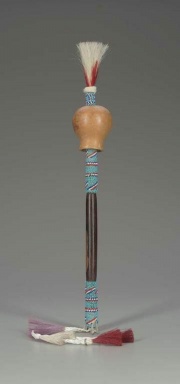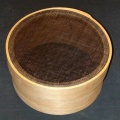Difference between revisions of "Horsehair"
| Line 1: | Line 1: | ||
| − | [[File:1984.314-SC29777.jpg|thumb|]] | + | [[File:1984.314-SC29777.jpg|thumb|Vessel rattle<br>MFA# 1984.314]] |
== Description == | == Description == | ||
The hair from the manes and tails of horses (family ''Equidae''). Horsehair is primarily produced commercially from China, Russia, Australia, Canada, Uruguay, and Argentina. Horsehair is usually coarse and strong. The resilient, lightweight fibers are used for industrial paint and household [[brush|brushes]]. Short or curled horsehairs are used for mattress and upholstery padding while the longest fibers are used for making horsehair cloth. Horsehair cloth was formerly used as interlining or stiffening for tailored garments and millinery but is being replaced synthetic fabrics. Horsehair mats have been used as an [[abrasive]] for polishing [[veneer]], burnishing [[clay]], and smoothing [[gesso]] grounds. High quality, fine, white horsehair is used for the strings of fine violin bows. Cut tips from these fibers have been used for artist and domestic brushes, but the hairs are inelastic and often fail to hold their shape. Strainers made from horsehairs are customarily used to filter Japanese [[starch paste]]. | The hair from the manes and tails of horses (family ''Equidae''). Horsehair is primarily produced commercially from China, Russia, Australia, Canada, Uruguay, and Argentina. Horsehair is usually coarse and strong. The resilient, lightweight fibers are used for industrial paint and household [[brush|brushes]]. Short or curled horsehairs are used for mattress and upholstery padding while the longest fibers are used for making horsehair cloth. Horsehair cloth was formerly used as interlining or stiffening for tailored garments and millinery but is being replaced synthetic fabrics. Horsehair mats have been used as an [[abrasive]] for polishing [[veneer]], burnishing [[clay]], and smoothing [[gesso]] grounds. High quality, fine, white horsehair is used for the strings of fine violin bows. Cut tips from these fibers have been used for artist and domestic brushes, but the hairs are inelastic and often fail to hold their shape. Strainers made from horsehairs are customarily used to filter Japanese [[starch paste]]. | ||
| − | [[File:1991.962-SC83947.jpg|thumb|]] | + | [[File:1991.962-SC83947.jpg|thumb|Lakota shirt<br>MFA# 1991.962]] |
== Synonyms and Related Terms == | == Synonyms and Related Terms == | ||
| Line 10: | Line 10: | ||
horse hair; horsehair cloth; pony hair | horse hair; horsehair cloth; pony hair | ||
| − | == | + | == Physical and Chemical Properties == |
Mane: Length = 7.5 - 20 cm (3 - 8 inches); Diameter = 50 - 150 micrometers Tail: Length = 20 - 90 cm (8 - 36 inches); Diameter = 75 - 280 micrometers | Mane: Length = 7.5 - 20 cm (3 - 8 inches); Diameter = 50 - 150 micrometers Tail: Length = 20 - 90 cm (8 - 36 inches); Diameter = 75 - 280 micrometers | ||
| Line 28: | Line 28: | ||
</gallery> | </gallery> | ||
| − | + | == Resources and Citations == | |
| − | == | ||
* M. Doerner, ''The Materials of the Artist'', Harcourt, Brace & Co., 1934 | * M. Doerner, ''The Materials of the Artist'', Harcourt, Brace & Co., 1934 | ||
| Line 39: | Line 38: | ||
* ''Identification of Textile Materials'', The Textile Institute, Manchester, England, 1985 | * ''Identification of Textile Materials'', The Textile Institute, Manchester, England, 1985 | ||
| − | * | + | * WAAC Newsletter - Volume 8, Number 3, Sept. 1986, pp.11-12 - . Horsehair strainer, a classical Japanese paste strainer... |
| − | * ''Encyclopedia Britannica'', http://www.britannica.com Comment: "Horsehair." | + | * ''Encyclopedia Britannica'', http://www.britannica.com Comment: "Horsehair." (Accessed 28 Apr. 2004). |
* Edward Reich, Carlton J. Siegler, ''Consumer Goods: How to Know and Use Them'', American Book Company, New York City, 1937 | * Edward Reich, Carlton J. Siegler, ''Consumer Goods: How to Know and Use Them'', American Book Company, New York City, 1937 | ||
Latest revision as of 14:38, 18 October 2020
Description
The hair from the manes and tails of horses (family Equidae). Horsehair is primarily produced commercially from China, Russia, Australia, Canada, Uruguay, and Argentina. Horsehair is usually coarse and strong. The resilient, lightweight fibers are used for industrial paint and household brushes. Short or curled horsehairs are used for mattress and upholstery padding while the longest fibers are used for making horsehair cloth. Horsehair cloth was formerly used as interlining or stiffening for tailored garments and millinery but is being replaced synthetic fabrics. Horsehair mats have been used as an Abrasive for polishing Veneer, burnishing Clay, and smoothing Gesso grounds. High quality, fine, white horsehair is used for the strings of fine violin bows. Cut tips from these fibers have been used for artist and domestic brushes, but the hairs are inelastic and often fail to hold their shape. Strainers made from horsehairs are customarily used to filter Japanese Starch paste.
Synonyms and Related Terms
horse hair; horsehair cloth; pony hair
Physical and Chemical Properties
Mane: Length = 7.5 - 20 cm (3 - 8 inches); Diameter = 50 - 150 micrometers Tail: Length = 20 - 90 cm (8 - 36 inches); Diameter = 75 - 280 micrometers
Comparisons
Properties of Common Abrasives
Additional Images
Resources and Citations
- M. Doerner, The Materials of the Artist, Harcourt, Brace & Co., 1934
- G.S.Brady, Materials Handbook, McGraw-Hill Book Co., New York, 1971 Comment: p. 124
- Hermann Kuhn, Conservation and Restoration of Works of Art and Antiquities, Butterworths, London, 1986
- Identification of Textile Materials, The Textile Institute, Manchester, England, 1985
- WAAC Newsletter - Volume 8, Number 3, Sept. 1986, pp.11-12 - . Horsehair strainer, a classical Japanese paste strainer...
- Encyclopedia Britannica, http://www.britannica.com Comment: "Horsehair." (Accessed 28 Apr. 2004).
- Edward Reich, Carlton J. Siegler, Consumer Goods: How to Know and Use Them, American Book Company, New York City, 1937
- F. Kidd, Brushmaking Materials, Bristish Brush Manufacturers, London, 1957
- Zora Sweet Pinney, 'A Handle on the Terms used for Artists' Brushes', unpublished glossary, 1999




